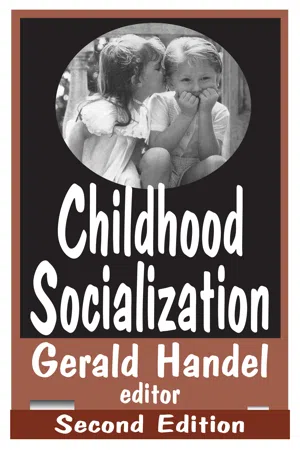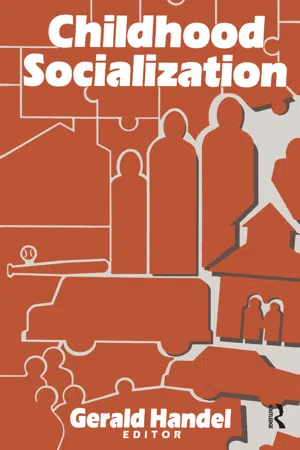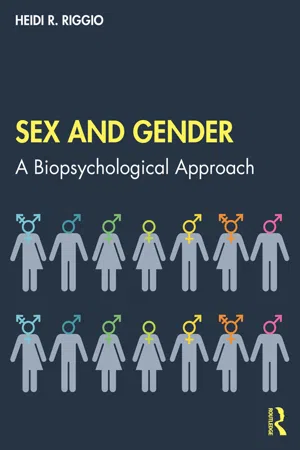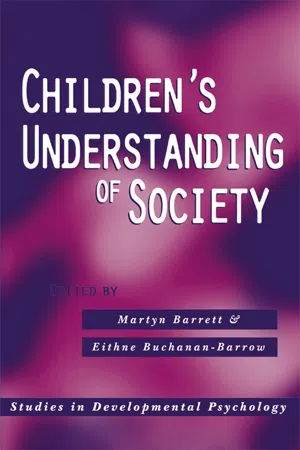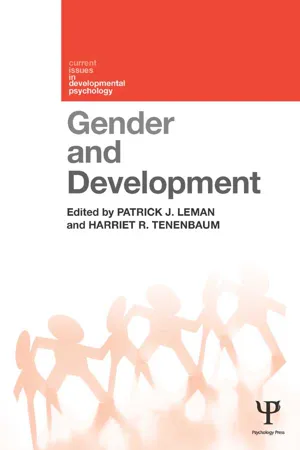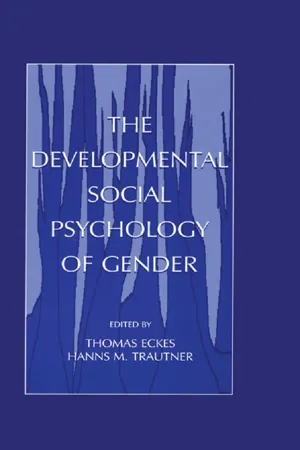Psychology
Gender Roles in Society
Gender roles in society refer to the societal expectations, behaviors, and attitudes that are considered appropriate for individuals based on their perceived or assigned gender. These roles can influence various aspects of life, including work, family, and relationships. They are often shaped by cultural norms and can impact individuals' self-concept and psychological well-being.
Written by Perlego with AI-assistance
Related key terms
12 Key excerpts on "Gender Roles in Society"
- eBook - ePub
Adaptation and Well-Being
Meeting the Challenges of Life
- Knud Larsen(Author)
- 2017(Publication Date)
- Routledge(Publisher)
The total psychological and socio-cultural dimensions associated with being male or female are referred to as gender. Gender roles are defined as social expectations for gender-appropriate behavior, thoughts and emotions. Nevertheless, despite the normative changes of the last few decades, gender roles have deep cultural roots that are socialized early in life and remain largely unconscious for most people. At the same time in today’s world, there are considerable strains and stresses about gender roles where some sectors of society hold on to traditional beliefs that, in turn, conflict with more modern egalitarian views. Role-related conflict contributes to unease in the relationships between men and women as they each try to understand and accept the new realities of greater equality (Lippa, 2005; Zhou, Dawson, Herr & Stukas, 2004).Gender differencesSociety has, in the past, cultivated gender stereotypes, many of which go back to the beginning of human civilization. The platform that supports these beliefs is the physiological sexual differences and the distinct roles played in reproduction by men and women. However, it is society that has reified these beliefs and anchored these deep in the psyche of both genders. Perhaps the most obvious stereotype is the common belief that women are weak and men are powerful and dominant. More recently derived stereotypes suggest that men are good with numbers and mechanical arts, whereas women have greater skills in nurturing relationships and children. Also common in many societies is the belief that women are more emotional than men, more sensitive and more likely to express their feelings in both joyful occasions and in unhappiness. These gender-related beliefs are nevertheless overgeneralizations that are fostered and reinforced by social institutions from the moment a child is born. For example, in the United States a baby girl is wrapped in a pink blanket and typically, as she grows older, is given dolls or soft toys to play with, whereas boys are wrapped in blue blankets and given toys such as trucks or soldiers that reinforce masculine assertiveness. These generalized beliefs are not evaluated, but rather are largely unconscious and accepted as givens by nearly everyone in society. Even though we are unaware of the presence of gender stereotypes, many people nevertheless behave and think consistently with these stereotypes in ways that often limit life opportunities and experiences of girls and women. While differences have been found for a number of dimensions, it is important to ask if the differences are large enough to be meaningful (Hyde, 2005). - eBook - ePub
- Theron Alexander(Author)
- 2017(Publication Date)
- Routledge(Publisher)
gender roles to refer to what is socially expected. In the last forty years there have been many dramatic changes in gender roles. Consider that forty years ago women were widely believed not fit for high political office. At this writing, 10 out of the 100 United States Senators are women, and women have been state governors, mayors, and held many other important political offices. In other countries, women have held even higher offices. Gender roles changed to make this kind of work and such high statuses available to women. Many societies reinterpreted gender and recognized that it was not dictated by biological sex.Sociologists now recognize that gender is socially constructed. Ideas, beliefs, values, and emotions about gender are promulgated in a variety of institutions— through images in movies and television, practices and preachings in churches, synagogues, and mosques, practices and teachings in school classrooms and playgrounds. For any individual child, gender begins to be constructed in the family. Sociologist Scott Coltrane reviews the major theories that seek to understand the part parents play in children’s development. He then discusses many different kinds of studies that illuminate parental practices in shaping their children’s gender.As a result of a review of various studies, psychologist David Lisak develops a thoughtful but provocative argument that gender socialization of males is a major factor in the perpetration of sexual abuse. The path is not a direct one, and he recognizes that not all males are gender socialized in the same way. But he identifies a socialization pattern that he considers widespread and that he calls “warrior masculinity” which is based on denial of fear and any form of vulnerability. This leads, in turn, to emotional deficits, including, importantly, a reduced ability to have empathy for the feelings of others. His chapter may not be the last word on this subject, but his discussion of the emotional socialization of males rings true as a common pattern, if not the only one. Chapter 5 - eBook - ePub
- Gerald Handel(Author)
- 2020(Publication Date)
- Routledge(Publisher)
VII Socialization to GenderThe division of the human species into male and female sexes, which gives men and women complementary roles in biological reproduction, has been interpreted in all societies as having wider social significance. Most significantly, men tend to hold more power than women. Their activities tend to be considered more important than women's, and therefore they tend to have more prestige. Many occupations are sex-typed, so that some are deemed more suitable for men, others more suitable for women, although still others may be equally open to either. Behavioral expectations often differ, as well. For example, women are allowed to be "more emotional" than men, except in the expression of anger, which is more fully allowed men.All of these expectations that are attributed by sex, connected not directly to reproduction but viewed as socially appropriate concomitants, have long been discussed under the concept of sex role. A growing realization that many of the concomitants have nothing to do with sex or reproduction but are social beliefs—which denigrate and subordinate women—led to a new terminological distinction between sex and gender. Some scholars no longer use the term sex role at all. Lipman-Blumen (1984) finds a use for and retains it, however, as well as adopting the now widely used term gender role. She defines each as follows: "sex roles, to refer specifically to behaviors determined by an individual's biological sex, such as menstruation, pregnancy, lactation, erection, orgasm, and seminal ejaculation" (p. 2). "Gender roles encompass all those cultural expectations associated with masculinity or femininity that go beyond biological sex differences" (p. 3).By differentiating gender and sex, it becomes easier to recognize that gender is, to a significant degree, the product of social institutions and of socialization. Though institutions are resistant to change, they nonetheless are demonstrably more modifiable than the biological division of the human species into male and female. - Michele Paludi, Gertrude A Steuernagel, Ellen Cole, Esther D Rothblum(Authors)
- 1990(Publication Date)
- Routledge(Publisher)
A coordinating theme in the study of the psychology of women is that the science of human behavior is not value-free. Thus, we all look at the world through our own unique lens, shaped by the personal experiences that influence our perception and evaluation of life events and the world around us. Although a science of human behavior requires that we test hypotheses and arrive at conclusions by means of carefully conducted research studies, even scientific research can be biased by the methods and procedures of the researcher. One of the unique contributions of the new psychology of women is the examination of gender bias in research and the development of guidelines and procedures to reduce this bias in research related to women’s development and behavior. The results of these efforts have been the discovery of new “facts” that contradict old “facts” and new insights into the experience and lives of women as well as of men.GENDER AND SEX-ROLE STEREOTYPES
In every culture, the impact of gender assignment on lifespan experiences is profound. The label of female or male itself provides a framework around which stereotyped expectations, role prescriptions, and life opportunities are organized. Gender stereotypes are simplified generalizations about females and males that are intended to apply to all persons within each gender group. Some of these stereotypes may be true for some individuals (e.g., men are stronger than women) but are seldom useful when understanding or describing a particular person.Sex roles consist of organized clusters of expectations for behaviors and activities that are considered to be appropriate and desirable for either females or males (Bem, 1974; Worell, 1978). Stereotyped conceptions about what is appropriately masculine or feminine for either ourselves or others can include at least five areas of behavior: Personality traits (e.g., aggressive or gentle), family roles (e.g., breadwinner or homemaker), leisure activities (football or knitting), work roles (miner or manicurist), and personal styles and appearance (swaggering or hipswinging). Although we are more likely to expect a coal miner to play football and swagger than to knit and bake bread, this is just one more example of stereotyped thinking in action. In reality, there is very little connection between our behavior in each of these domains (Orlofsky, 1981).Sex-Role Stereotypes in Action
How do these stereotypes affect our conceptions of the developing person? From the day of birth, parents and other adults express divergent expectations for girls and boys. In one study, both mothers and fathers of newborns described their infant daughters as smaller, softer, and less attentive than did parents of sons. Fathers rated their sons as stronger, more alert, and hardier than did fathers of daughters, despite the fact that there were no measurable differences between the two groups of babies (Rubin, Provenzano, & Luria, 1974). By the age of three years, girls and boys can identify many of the activities that are culturally stereotyped for their gender. For example, most children in a preschool sample believed that girls like to play with dolls, like to cook dinner and clean house, help mother, never hit, ask for help frequently, and will be a mother, nurse, or teacher when they grow up. In contrast, they also believed that as adults, the man will be “the boss” (Kuhn, Nash, & Bruken, 1978).- eBook - ePub
- Judith E. Owen Blakemore, Sheri A. Berenbaum, Lynn S. Liben(Authors)
- 2013(Publication Date)
- Psychology Press(Publisher)
In addition to the research on sex differences, there was also much ongoing research on gender stereotypes—what people think about how males and females are different. That research also found the people held rather consistent and predictable views about such differences. Importantly, the researchers found there was some degree of similarity between the sex differences that meta-analyses were uncovering, and the stereotypes that people had about males and females. That is, the stereotypes could be described as reasonably accurate.The consistency between the sex differences and gender stereotypes research raised questions about how they might be related. For example, if people think that young girls are delicate and in need of assistance, or that boys are rowdy and disobedient, does that have an impact on how boys and girls are treated? Then, does the treatment continue to influence the expected behavior? Do boys then become more rowdy and disobedient because of the way they are treated? For some time social psychologists have shown how powerful social expectancies are in shaping behavior. Eagly and her colleagues proposed that behavioral differences between males and females are affected by the stereotypes that people hold. Another important question is where the stereotypes come from in the first place. They proposed that the stereotypes that people hold about males and females are affected by the roles that men and women play. Roles lead to stereotypes, stereotypes lead to expectancies, expectancies lead to treatment, and treatment leads to behavior, and the whole process continues in a never-ending cycle.Gender Roles
At the center of social role theory is a focus on gender roles, especially the roles of homemaker and economic provider. The fact that men and women have these roles is obviously not a historical accident; they are related to the biological capacities of each, and to the production needs of societies. Certain tasks could be accomplished more easily and efficiently by one sex or the other. Men’s greater physical strength was needed for certain occupations and activities, especially in preindustrial societies. Women, on the other hand, become pregnant, give birth, and nurse infants, and hence it is not arbitrary that childcare responsibilities have shaped their lives throughout human history. - eBook - ePub
Sex and Gender
A Biopsychological Approach
- Heidi R. Riggio(Author)
- 2020(Publication Date)
- Routledge(Publisher)
gender-incongruent behavior is still punished and condemned in many cultures, experiences that are clearly meaningful for ideas and feelings about the self. In this way, questions about gender identity and the sociocultural construction of gender are necessarily intertwined. This is perhaps why there are multiple theories describing one or the other or both; how gender identity is formed, how social constructions of gender arise, or how social constructions of gender influence gender identity content and formation.Evolutionary psychology provides one perspective, emphasizing how individual gender identity and ideas and norms about gender enhance ability of humans to survive and reproduce. Many other explanations are offered, with different theories providing insight into and explanation of how gender identity and sociocultural ideas about gender develop and how they influence individual and group behavior. Why are there so many explanations, with not one single theory necessarily standing out as the best and most comprehensive? As with most human behaviors, the development and experience of gender identity is complex; it is linked with genetic processes, physiological and hormonal processes, in utero events, socialization, family experiences in early childhood, exposure to various media, experiences with developing sexuality, and so on. It influences individual self-concept, self-esteem, feelings of belonging and well-being, lifestyle, relationships, career pursuits, and many other important psychological and social outcomes. How about ideas that societies and cultures develop to explain what it means to be female, or what it means to be male? Gender as a social construction, as an ideology involving traditions, expectations, and norms for behavior, is extremely complex in trying to observe, understand, and explain. Because of the complexity involved in human behavior, sometimes there are various complementary and competing explanations for particular phenomena. As such, there are various theoretical approaches one can use in attempting to explain individual and social constructions of gender. This chapter will present prominent, important, and “good” theories of gender. - eBook - ePub
- John Coleman(Author)
- 2012(Publication Date)
- Routledge(Publisher)
The primary purpose of this chapter is to examine gender role learning as a complex and pervasive developmental process formed in a strong, societal context. The primary goals are to increase the reader’s gender role knowledgeability in order to understand these processes better and to sensitize the reader to opportunities for choices regarding one’s gender expectations for self as well as for others. This chapter has four foci. Addressed first is the issue of the language of sex and gender with an introduction to the multiple factors that contribute to the construction of gender. These sections are entitled ‘Definitions’ and The content of gender roles and stereotypes’. The second focus is on explanations as to why and how a gender role is learned as described in numerous, sometimes contrasting, sometimes complementary, theories. This section is entitled ‘Socialization processes and consequences’. Addressed third is the impact of socialization agents, such as parents, teachers, and media, on the developing child and adolescent; this section is entitled ‘Learning gender roles: the interfacing of socializing agents and children’. The final focus is on recommendations for changes to the learning environment. Encouraged is the consideration of flexible options for healthy, personally expressive growth for boys and girls, unhindered by artificially constructed stereotypes. These proposals for change are found in the section on ‘Learning to make choices’.DEFINITIONSThere are a number of labels that have been generated pertaining to our selves as males and females, such as sex and gender. Two categories, one based on our biology and the other on social construction, focus our attention on the determinants of the perceived differences between males and females. It is important that we recognize the reasons for the distinctions as well as the meanings of the sex and gender labels so that communication and understanding are maximized, and misconceptions and confusion minimized.Biological determinantsThe most basic label is that of defining individuals in terms of their sex. One is labelled male or female due to one’s sex chromosomes and/or anatomical sex structures, equating males with the presence of, for example, xy sex chromosomes and a penis, while females are usually defined by xx sex chromosomes and the presence of a vagina. As Unger (1979) has noted, hormones and other physical characteristics based on biological origins have also been used to distinguish the sexes. Height and percentage of body fat and muscle are typical examples. However, given the work of John Money and others (e.g. Baker and Ehrhardt 1978; Money and Wiedeking 1980), we have become increasingly aware of the fact that it may be inappropriate to categorize individuals as strictly male or female. Rather, levels of hormones and physical appearance exist along a continuum with extreme maleness anchoring one end and extreme femaleness anchoring the other end. There are males with rounded hips and breasts as well as females who are very flat-chested. Some individuals, usually genetic females, may experience androgenital syndrome whereby they receive an overabundance of the masculinizing androgen and, unless treated early with Cortisol, will appear male-like in their external genital structures and be raised as boys, perhaps requiring surgical procedures at adolescence. Some genetic males may be insensitive to the masculinizing effects of androgen – androgen insensitivity syndrome – and develop external female-like genitals and be raised as girls. Other individuals who carry the sex chromosomes of one sex, and who are born with ambiguous genitalia, undergo surgery in the first years of life with their genitalia corrected for consistency with the sex opposite to that designated by their sex chromosomes (in line with the likelihood of surgical success given the genital structure with which the child is born), and are reared as this opposite sex. There are also intersex children who have been reared as one sex, undergone substantial physical change at puberty, and have been redefined in terms of their sex at adolescence (Imperato-McGinley et al. 1974; Lott 1987). Still others are born with sex chromosomal abnormalities, such as Turner’s syndrome, Klinefelter’s syndrome or the double-y syndrome - eBook - ePub
Educating the Other
Gender, Power and Schooling
- Dr Carrie Paechter, Carrie Paechter(Authors)
- 2002(Publication Date)
- Routledge(Publisher)
Gender dimorphism, including biological dimorphism, is constructed for particular ends; power relations between men and women in Western society require an exaggeration of the differences between them (McNay, 1992; Connell, 1987; di Stefano, 1990). Perceived biological differences are translated into mutually-exclusive gender roles in which what is expected of males and females is played out. Those things particular to the masculine role (in Western society, work outside the home, aggressive behaviour) are given power and status; those to the feminine (care of children, ‘service’ jobs) are not. Generally, it would appear that the status of an occupation or preference is directly related to which gender is usually associated with it. For example, when typewriters were first invented, they were usually operated by the one or two men in an office of female clerks; typing was seen as a skilled occupation with some status. As typewriters became more widespread, more women started using them, until typing became a low-status, almost entirely feminized, occupation.Because gender-role differences are so intimately bound up with power relations, their construction is asymmetrical in a number of ways. In our everyday gender attributions, it is male rather than female markers that are salient; as in assignment at birth, the sign of femaleness is the absence of male cues. This is even the case for infants born with ambiguous genitalia: Kessler (1990) notes that the key indicator for the assignment of such an individual as male is the presence (or potential presence, after surgery and hormone treatment) of an adequately functioning penis; if this is not considered achievable, the child is reared as female and a vulva and vagina constructed if necessary.The guidelines are clear, but they focus on only one physical feature, one that is distinctly imbued with cultural meaning. This becomes especially apparent in the case of an XX infant with normal female reproductive gonads and a perfect penis. Would the size and shape of the penis, in this case, be the deciding factor in assigning the infant ‘male’, or would the perfect penis be surgically destroyed and female genitals created?… researchers concur that parents are likely to want to raise a child with a normal-shaped penis (regardless of size) as ‘male’, particularly if the scrotal area looks normal and if the parents have no experience with intersexuality…This reasoning implies…that it is preferable to remove the internal female organs, implant prosthetic testes, and regulate the ‘boy’s’ hormones for his entire life than to overlook or disregard the perfection of the penis, (pp. 18–19) - eBook - ePub
- Martyn Barrett, Eithne Buchanan-Barrow(Authors)
- 2004(Publication Date)
- Psychology Press(Publisher)
In sum, cognitive developmental approaches have contributed a major impetus to the study of gender role development per se and to our knowledge of children's understanding of gender in particular. These are not quite the same thing, and cognitive developmentalists have been criticised for assuming they are (see Bussey & Bandura, 1999; Martin et al., 2002, for discussions). Kohlberg's (1966) model provided a valuable structure for research into early understanding; in some respects, it has been borne out but in others (most notably, gender constancy) it remains controversial (see Lutz & Ruble, 1995). Martin and Halverson's gender schema theory has advanced the field considerably by, among other contributions, highlighting the ways in which children's developing theories of gender guide their interpretation of the social environment and their inferences about it. In more recent developments, this has led to promising intersection with social psychology, in the form of Martin's (2000) sketch of a naїve social psychology of gender, related overlaps with other current work in the application of social identity theory/self-categorisation theory to developmental issues (Powlishta, in press; Ruble et al., in press), and in the study of emotional development in social context. In these ways, research in this field is beginning to ameliorate a ``blind spot'' of developmental research, namely social influence (Eckes & Trautner, 2000).UNDERSTANDING GENDER ROLES IN THE MEDIA
If we admit that the development of gender role understanding is sensitive to the surrounding culture (Bussey & Bandura, 1999), then the media stand out as omnipresent and relatively quantifiable components of that culture ― as well as being very attractive to young people. Self-evidently, this comment applies only to recent and contemporary cultures, and only in some parts of the world; it is worth bearing in mind that for the larger part of human history, and still today in some societies, communities have evolved differentiated patterns of gender roles, which they have maintained and transmitted to the next generation efficiently and powerfully, without any involvement of the mass media. Nevertheless, the media are important as a collective representation of what gender means and as a guide to what is valued within a society. Of course, the media do not function democratically in respect of representing the diversity of gender ideologies, nor are they faithfully reflective of the demographic structure of their societies or the capacities of individuals, but they do stand as a reflection of how gender is organised and they thereby provide children with a ``window'' on societal images of gender. The question of interest, then, is how might the media be related to children's understanding of Gender Roles in Society? - eBook - ePub
- Patrick Leman, Harriet Tenenbaum(Authors)
- 2013(Publication Date)
- Psychology Press(Publisher)
Research has established that even though there has been a steady increase in the number of women who work outside the home, there is still the prevailing stereotype that women are more nurturing and are more suited for caretaking than men (Gorman & Fritzsche, 2002). Belief in as well as adherence to these gender expectations can limit individuals of all ages in their exploration of viable occupations, such that they may be denied access or may self-select occupations that allow them to focus on being in either the primary breadwinner or caretaker role in their families. This section of the chapter will review research from the social role theory first as it provides foundational evidence of why many adults might adhere to gender expectations within the career and family contexts. The chapter will then introduce and review developmental research grounded in the social domain theory, which moves the adult research further by exploring children's and adolescents' social cognition about these adult roles with the goal of understanding why these gender expectations might continue to exist.According to research based in the social role theory, adults associate men and women with their primary roles and develop stereotypes based on the characteristics they presume are necessary for each of these roles. Furthermore, gender role ideologies are based on socialization processes and individuals' experiences with roles as they are modelled. In this way, women are more often associated with the caretaker role and the family, and men are more often associated with the role of breadwinner and career (for a review, see Eagly & Wood, 2012).A further assumption of social role theory is that stereotypes can change as the roles of men and women shift over time (Diekman & Eagly, 2000). Many of the studies about gender roles in the home have been conducted with university-age students or adults and the prevailing finding is that while women expect to work outside the home, they also expect and anticipate having to do more household work and caretaking (Askari et al., 2010; Fetterolf & Eagly, 2011; Kaufman, 2005). Men and women do not differ in their desire for marriage and family (Erchull et al., 2010), yet women anticipate that they will have to balance their careers with child-rearing responsibilities and understand that there may be a conflict between raising a family and having a successful career (Fetterolf & Eagly, 2011). Research has not found that men anticipate this same kind of conflict and many college-age men still express the desire to have a wife who will stay home with the children while they are young (Stone & McKee, 2000). While more researchers are arguing that men's and women's overall workloads are moving towards equality (Bianchi et al., 2006), there is not enough empirical evidence from the social role theory to suggest a change in the societal perception that one of women's primary roles should be to serve as the family's caretaker. - eBook - ePub
Growing Points in Developmental Science
An Introduction
- Willard W. Hartup, Rainer K. Silbereisen(Authors)
- 2005(Publication Date)
- Psychology Press(Publisher)
Sometimes the use of the word “stereotypes” is taken to mean that attributes assimilated to social categories are arbitrary, so that our concepts about the two sexes may be quite artificial or distorted. How accurate are our gender stereotypes? In their review, Deaux and LaFrance (1998) note that it is hardly possible to check the reality base of some of our stereotypes, since they refer to characteristics that are very difficult to measure objectively. People’s beliefs about certain attributes of the two sexes that can be objectively assessed, however, turn out to be quite accurate (e.g., that women are more involved than men in the care of young children). This work has been done with adults, and we can only assume that the accuracy of children’s gender stereotypes would improve with age, as they accumulate information about a larger and larger sample of exemplars.At the end of the twentieth century, then, a predominant perspective on gender development is a dual one focusing on individual differences. Its central themes are that children will differ in the degree to which they become sex-typed as a result of (a) the strength of the socialisation pressures they have experienced, and (b) the nature and coherence of their gender schemas—their knowledge about the characteristics stereotypically associated with each sex, and about what the social expectations are for persons of their own sex. Or course, socialisation and cognitive factors in gender development are not truly distinct. For example, socialisation pressures are one source of information enabling children to develop their knowledge concerning the gendered norms that they are expected to adopt. The direct socialisation experiences children have, in other words, constitute a major source of information upon which cognitive structures are built. Indeed, the whole cultural milieu in which a child grows up presents to children an array of cultural beliefs and practices concerning gender, and when children draw on these to construct their gender schemas, it can reasonably be said that they are being socialised by the surrounding culture into becoming co-practitioners of these cultural forms.An emphasis on cognitive and socialisation factors by no means precludes a recognition of possible biological influences that may generate different predispositions in boys and girls. Nowadays there is widespread recognition of the importance of biological factors. However, since biological sex and socially ascribed gender are so completely redundant, it has proved difficult to tease them apart. Something is known concerning sex differences in brain structures and functions. For example, in males, more functions are lateralised, so that they are associated with activation primarily in one hemisphere of the brain, whereas in females, the two hemispheres are more likely to be both activated for a specific function. However the possible behavioural impacts of these structural differences are far from being understood. A good deal is known concerning the physiological events during gestation that differentiate the genital structures of male and female foetuses. And we know, too, something about the way in which prenatal hormones organise the developing foetal brain so as to create different propensities and sensitivities in the two sexes—tendencies that will manifest themselves behaviourally at various times during postnatal development, perhaps requiring either a biological or environmental trigger for their activation. - eBook - ePub
- Thomas Eckes, Hanns M. Trautner(Authors)
- 2012(Publication Date)
- Psychology Press(Publisher)
Eagly’s (1987) social role theory examines how the stimulus environment encourages the development of particular gender-related beliefs. This approach focuses explicitly on gender stereotyping, emphasizing the contribution of current social arrangements to adult conceptions of men and women (see also Eagly, Wood, & Diekman, chap. 5, this volume).Social role theory suggests that societal divisions of labor, in which men are more likely to occupy paid positions and women are (relatively) more likely to occupy domestic roles, contribute to people’s expectations of men and women. The essence of the argument runs as follows:- People expect paid employees to be agentic and homemakers to be communal.
- These expectations elicit confirmatory behavior, so that paid employees demonstrate agentic behavior and homemakers demonstrate communal behavior.
- Both the occupant of the role and surrounding observers attribute role-consistent behavior to the gender of the individual rather than to social forces.
- Men disproportionately occupy positions as paid employees, whereas women disproportionately occupy positions as homemakers; hence, men are more often seen as agentic, whereas women are more often seen as communal.
A corollary of the argument states that gender stereotyping is best addressed by a redistribution of social roles. If men and women occupied equivalent social roles, then their behavior would look similar, and gender would become less meaningful.The social role approach may illuminate important causes behind stereotype use in early development. For young children, role divisions correlate with gender as highly as, if not more highly than, they do in adulthood. Moving from social role theory, we can speculate on how these associations affect stereotype development.In early childhood, then, the first woman that children usually encounter is their mother, whom they see in the role of a caretaker. Early, frequent, and intimate interaction with the mother in this role—the moment-to-moment soothing, smiling, gurgling, talking, and feeding—may teach the infant what it means to be female. This close contact may encourage the formation of female stereotypes, including the particular beliefs that women are likely to be caregivers, and that women are warm and nurturing. Meanwhile, the first man that children encounter is their father, whose primary occupation is usually outside of the home. In contrast to maternal experiences, infants typically have fewer opportunities to interact with their fathers. This means that they largely infer (rather than experience) the characteristics of men. As a result, stereotypes of men should be less well-organized than those of women, and the content should be related to achievement and competence more than to sociality—as it is.
Index pages curate the most relevant extracts from our library of academic textbooks. They’ve been created using an in-house natural language model (NLM), each adding context and meaning to key research topics.

